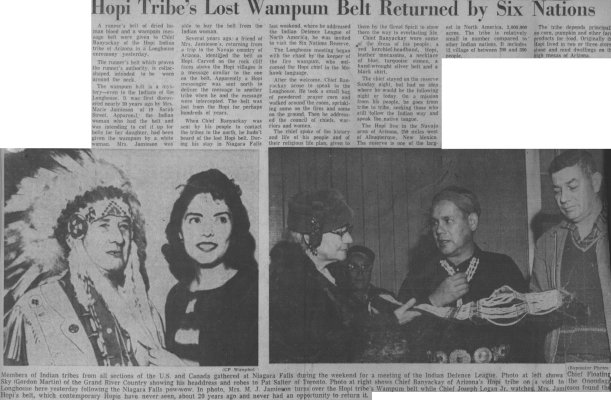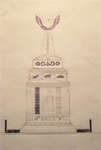Hopi Tribe's Lost Wampum Belt Returned by Six Nations
- Full Text
- Hopi Tribe's Lost Wampum Belt Returned by Six Nations
A runner's belt of dried human blood and a wampum message belt were given to Chief Banyackay of the Hopi Indian tribe of Arizona in a Longhouse ceremony yesterday.
The runner's belt which proves the runner's authority, is collar-shaped, intended to be worn around the neck.
The wampum belt is a mystery - even to the Indians of the Longhouse. It was first discovered nearly 20 years ago by Mrs. Marie Jamieson of 19 Sarah Street. Apparently the Indian woman who had the belt and was intending to cut it up for belts for her daughter, had been given the wampum by a white woman. Mrs. Jamieson was able to buy the belt from the Indian woman.
Several years ago, a friend of Mrs. Jamieson's returning from a trip to the Navajo country of Arizona, identified the belt as Hopi. Carved on the rock cliff faces above the Hopi villages is a message similar to the one on the belt. Apparently a Hopi messenger was sent north to deliver the message to another tribe when he and the message were intercepted. The belt was lost from the Hopi for perhaps hundreds of years.
When Chief Banyackay was sent by his people to contact the tribes to the north, he hadn't heard of the lost Hopi belt. During his stay in Niagara Falls last weekend, where he addressed the Indian Defence League of North America, he was invited to visit the Six Nations Reserve.
The Longhouse meeting began with the chant by the keeper of the fire wampum, who welcomed the Hopi chief in the Mohawk language.
After the welcome, Chief Banyackay arose to speak to the Longhouse. He took a small bag of powdered prayer corn and walked around the room, sprinkling some on the fires and some on the ground. Then he addressed the council of chiefs, warriors and women.
The chief spoke of the history and life of his people and of their religious life plan, given to them by the Great Spirit to show them the way to everlasting life.
Chief Banyackay wore some of the dress of his people; a red kerchief-headband, Hopi leather mocassins, a necklace of blue, turquoise stones, a hand-wrought silver belt and a black shirt.
The chief stayed on the reserve Sunday night, but had no idea where he would be the following night or today. On a mission from his people, he goes from tribe to tribe, seeking those who still follow the Indian way and speak the native tongue.
The Hopi live in the Navajo area of Arizona, 250 miles west of Albuquerque, New Mexico. The reserve is one of the largest in North America, 2,000,000 acres. The tribe is relatively small in number compared to other Indian nations. It includes 12 village of between 200 and 300 people.
The tribe depends principally on corn, pumpkin and other farm products for food. Originally the Hopi lived in two or three storey stone and mud dwellings on the high mesas of Arizona.
- Creator
- The Brantford Expositor, Publisher
- Media Type
- Text
- Newspaper
- Item Types
- Newspapers
- Clippings
- Description
- Article discussing Six Nations' return of a runner's belt to the Hopi Chief Banyackay in a ceremony at the Onondaga Longhouse.
- Publisher
- The Brantford Expositor
- Place of Publication
- Brantford
- Date of Original
- c. 1950s
- Subject(s)
- Personal Name(s)
- Jamieson, Marie ; Martin, Gordon ; Salter, Pat
- Local identifier
- SNPL000429v00d
- Language of Item
- English
- Geographic Coverage
-
-
Ontario, Canada
Latitude: 43.10012 Longitude: -79.06627
-
- Creative Commons licence
 [more details]
[more details]- Copyright Statement
- Copyright status unknown. Responsibility for determining the copyright status and any use rests exclusively with the user.
- Contact
- Six Nations Public LibraryEmail:info@snpl.ca
Website:
Agency street/mail address:1679 Chiefswood Rd
PO Box 149
Ohsweken, ON N0A 1M0
519-445-2954



